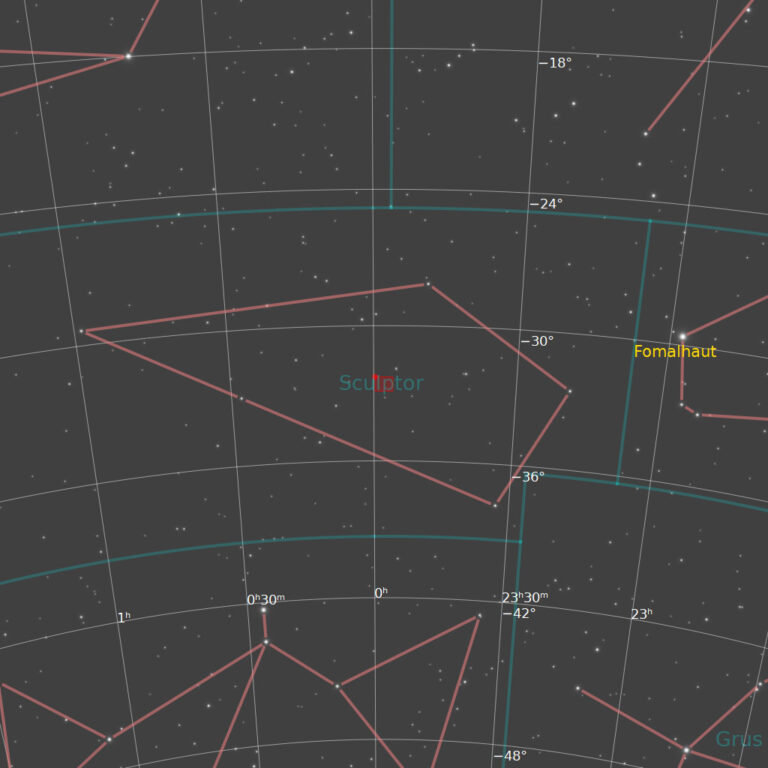NGC 7793
Flocculent Spiral Galaxy, Sculptor
- Description
- Technical
- Links
NGC 7793 is a flocculent spiral galaxy in the southern constellation of Sculptor. It was discovered in 1826 by Scottish astronomer James Dunlop. The galaxy is located at a distance of 12.2 million light years and is receding with a heliocentric radial velocity of 227 km/s. NGC 7793 is one of the five brightest galaxies within the Sculptor Group.
The morphological class of NGC 7793 is SA(s)d, indicating it is unbarred spiral galaxy (SA) with no inner ring structure(s) and the arms are loosely wound and disorganized (d). It is flocculent in appearance with a very small bulge and a star cluster at the nucleus. The galactic disk is inclined at an angle of 53.7° to the line of sight from the Earth. The visible profile is elliptical in form with an angular size of 9.3′ × 6.3′ and a major axis aligned along a position angle of 99.3°. There are two nearby dwarf galaxy companions.
On March 25, 2008, a type II-P supernova designated SN 2008bk was discovered in NGC 7793. At apparent magnitude 12.5, it became the 2nd brightest supernova of 2008. The progenitor of this supernova was a red supergiant, observed only 547 days prior to the explosion.
Jets from a black hole named P13 power a large nebula designated S26 in the outer spiral of this galaxy. Recently, the mass of P13 was determined to be less than 15 solar masses, and its companion star is estimated to be around 20 solar masses. The two orbit each other in 64 days. Based on this estimate, P13 is stripping material away from a nearby star about ten times faster than was previously believed to be physically possible. If correct, this observation would show flaws in theories that a black hole’s mass and rate of consumption are a fixed relationship.
The morphological class of NGC 7793 is SA(s)d, indicating it is unbarred spiral galaxy (SA) with no inner ring structure(s) and the arms are loosely wound and disorganized (d). It is flocculent in appearance with a very small bulge and a star cluster at the nucleus. The galactic disk is inclined at an angle of 53.7° to the line of sight from the Earth. The visible profile is elliptical in form with an angular size of 9.3′ × 6.3′ and a major axis aligned along a position angle of 99.3°. There are two nearby dwarf galaxy companions.
On March 25, 2008, a type II-P supernova designated SN 2008bk was discovered in NGC 7793. At apparent magnitude 12.5, it became the 2nd brightest supernova of 2008. The progenitor of this supernova was a red supergiant, observed only 547 days prior to the explosion.
Jets from a black hole named P13 power a large nebula designated S26 in the outer spiral of this galaxy. Recently, the mass of P13 was determined to be less than 15 solar masses, and its companion star is estimated to be around 20 solar masses. The two orbit each other in 64 days. Based on this estimate, P13 is stripping material away from a nearby star about ten times faster than was previously believed to be physically possible. If correct, this observation would show flaws in theories that a black hole’s mass and rate of consumption are a fixed relationship.
Telescope: Planewave CDK17 (FR) f4.5
Mount: Astro Physics 1600GTO
Camera: QHY16200A/ Integral FW
Guider: Agena Starguide II / ZWO ASI178MM
Filters: Astronomik 36mm LRGB
L: 60×10 mins = 600 mins, R: 24×10 mins = 240 mins, G: 24×10 mins = 240 mins, B: 24×10 mins = 240 mins
Total Imaging Time: 22h 00m
Data Imaged remotely on 6 nights during September 2024.
Imaged from Observatorio El Sauce, Chile, in partnership with Fred Espenak.
Data acquisition & Processing by David Churchill.
None


